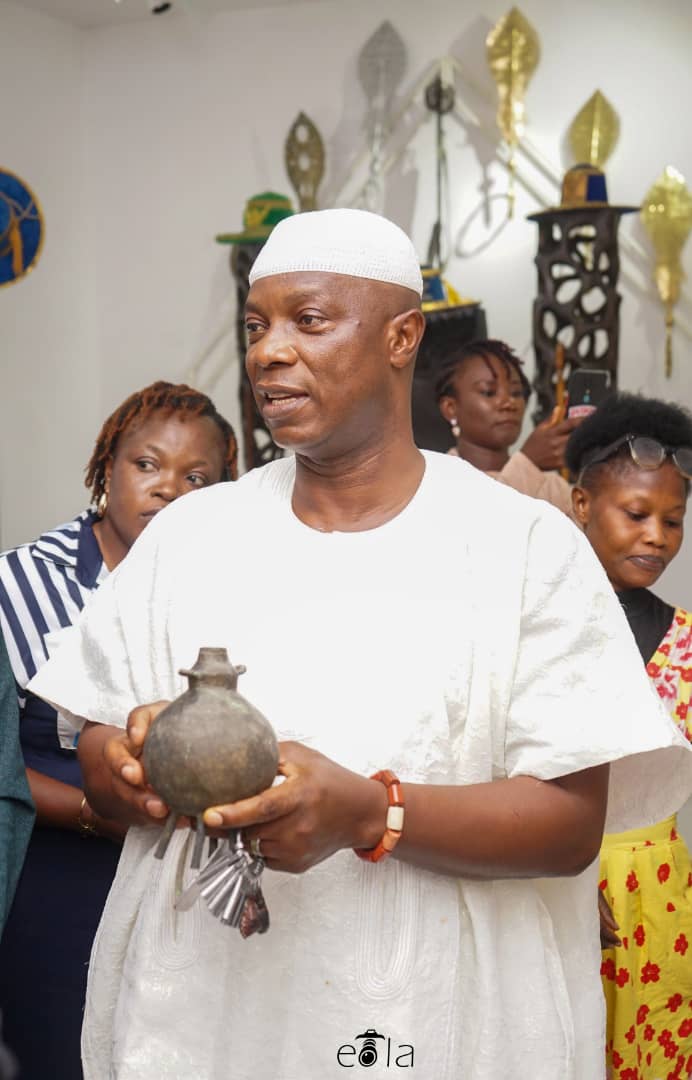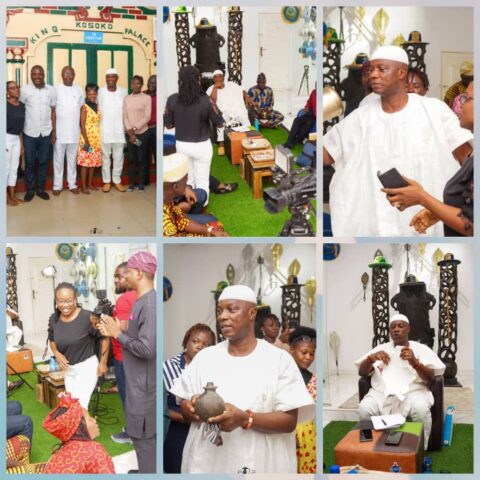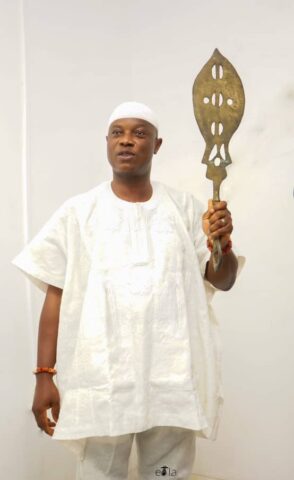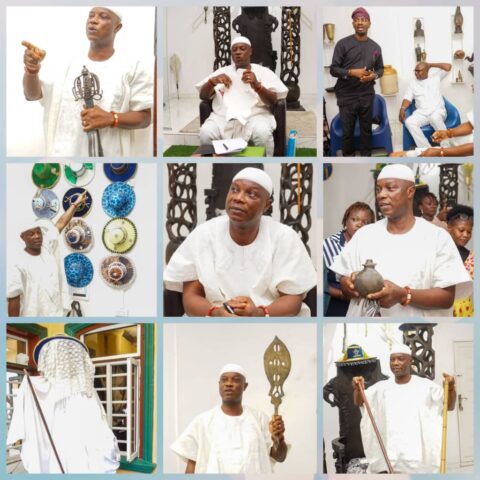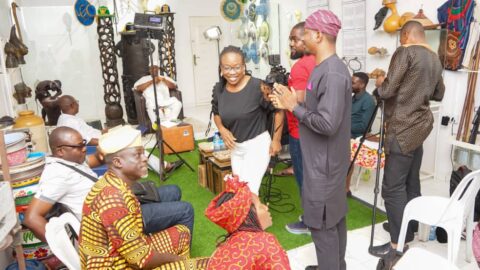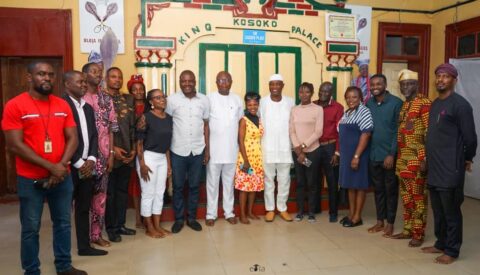By Frank Pen-Gun
The Oloja Elect of Lagos State, made a call when a Wikipedia Fact-Cheking team, working on the Wiki Loves Lagos Project in collaboration with the officials of the Lagos Council for Arts and Culture, and the Iga team, went on a fact finding mission to interview the current Oloja Elect of Lagos State, Prince Abiola Olojo-Kosoko.
In a historic visit which can be said to be a schooling in history, on the “Chronicles of Kosoko and the Birth of Lagos,” in his welcome address, the Oloja Elect of Lagos, urged Nigerians (in Lagos especially), to continue to uphold the legacies of his progenitor, the late “Oba Kosoko” – the foremost Oloja of Ereko/Lagos.
There in the palace, the Oloja told the true story of the emergence of Lagos State from the lineage of his progenitor, and that late Oba Kosoko was instrumental to the birth and development of Lagos State.
He narrated that; “His progenitor’s real name is Moronfolu Eshilokun. The name ‘KOSOKO’ was given to him due to circumstances surrounding his births, deaths and rebirths (reincarnation), reoccuring for about six (6) consecutive times. Kosoko was the first child of his father, Prince Eshilokun (the fourth son of Oba Ologun Kutéré – 1757). Kosoko’s father was married to Princess Omoyeni of Ewu Clan (presently, Ikeja, Egbeda).
The boy child (Kosoko), usually dies at a particular age of 6 or 7, and whenever it happens, before they bury him, somewhere on his body is marked. Whenever his mother gets pregnant and gives birth again, same mark was found on him, and that was how they knew he was the one who was reborn each time.
When Princess Omoyeni got pregnant the 6th time, before giving birth, Ologun Kutéré (Kosoko’s grandfather – the then king), consulted Ifa, and they were told by the gods that “this child that is coming, is also the same person”, and so should not be buried, because if the child is buried this time around, he may not come back again; and that the child should be taken to a shoreline where there are limestones (chalk), in an area presently called Ebute Elefun in Lagos. So, when Kosoko was reborn, they did as directed by the Ifa. And like the gods said, before noon, Kosoko came back home, and with two sacred stones. After his return, the people said, “Ko s’ókó ti ama fi sïn; ko s’ókó ti ama fi ro le; ko s’ókó ti ama fi gbele; omo ti ko s’ókó lati fi sïn, oti kpada wale.” So, from those sayings, the name, “Kosoko” was coined, came into being, and came to be.
Already there was one sacred stone in the palace, so Kosoko brought two other ones (making them three), which brought about the saying, “Iwo, omo nónó kükuru meta l’odé Erekó” – the three stones representing three Esu (i.e. 3 deities said to be trustworthy and loyal to human beings, provided you do the required); namely, Esu ori omi, Óta inu omi and Esu ori ile. Those 3 deities are what made Kosoko what he became in Ereko, and part of what made the Kosoko’s what they are today in Lagos. Kosoko’s metaphysical powers are connected to those deities which are still very much alive; that’s why people do not come to Kosoko’s palace and say evil, for if they do, it may happen. Moreso, there are restricted places in the palace, going there unauthorized, could cause a man to loose his testicles or sight, and for a woman, it may cause her to menstruate till death. So, some things are attached to Kosoko.”
He continued and said, “Kosoko grew up in Iga-Iduganran palace. He had his private residence at Idumagbon, which was the quarters for all princes and princesses in Lagos. According to the Lagos Land Use Act and Acquisition of 1953 – 1960, Idumagbon is a land said to belong to princes and princesses of Lagos. As a matter of fact, about four (4) land properties of Kosoko are still there presently, with ownership certificate to show for it.
Kosoko’s grandfather was at that time, the Oba of Lagos. Just like his father, Kosoko was a very good slave trader. Slave trading business was one of a flourishing business in Iga-Iduganran, because it had one of the safest harbours that every merchant would want to use as a passage for their goods out of the shores of Lagos.That harbour is the current “Marina” in Lagos, also known as the Kosoko’s harbour. Then, the harbour was from the beginning of Broad Street to some parts of Isa Williams and wasn’t sand filled. It was sand filled about eighty six (86) years ago, when it was reclaimed and developed for the houses seen at the inner Marina. The outer Marina was reclaimed about 66 to 76 years ago, like between 1927 -1933. These were the boundary areas of Lagos. So most people use that place to take their goods out of Lagos.”
Prince Abiola Olojo-Kosoko described the late Kosoko as a very wealthy man, with international connections, whose wealth was mostly gotten from slave trading. He was in control of the whole of Lagos harbour (presently Marina in Lagos).
“But something again happened. Prince Eshilokun, (Kosoko’s father) was not in town when his father, Oba Ologun Kutéré died. He was far away in Mayın River (presently Ekpe). The Mayıns (now the Ilajes) are among the 3 sets of people that usually come to Lagos to be involved in the visiting fishing business. Lagos happen to be the fishing camp, that’s why it is called “Eko.” This was before 570AD, and it was controlled by the Oba of Benin.
Prince Eshilokun would later become King. After being on the throne for about 25 years, Eshilokun died. Kosoko was away, he wasn’t around then. So, due to his absence, in his place, his younger brother, Idewu Eshilokun was crowned the Oba of Lagos.
Idewu Eshilokun (the Oba and Kosoko’s junior brother), was afraid that Kosoko might one day dethrone him or come to battle him in the palace, and so, to avoid problem and make Kosoko happy, he conferred on him the title of “OLOJA of EREKO” . This was in 1833. Before then, there was no Lagos; Lagos came into existence in 1852.
So, Kosoko became the Oloja of Lagos. The whole place from the palace to Ebute Eru was his territory and still is. He collected levies and gave to his brother whatever he feels like giving to him. Kosoko would later appoint the first Iyaoloja of Lagos, in the person of Ólóri Efunre Tinubu, wife to Oba Adele Ajose (Kosoko’s uncle) – Kosoko wasn’t around when he was made King, and that was after the death of Oba Idewu. Idewu was made to choose to commit suicide by drinking from the ‘Pot of Secrecy’ which contained a poisonous concoction, as conspired by his people and the then Oba of Benin, because his people went to the Oba of Benin and complained bitterly that they were no longer comfortable with his reign; it was like a vote of no confidence. So, Oba Idewu’s reign was cut short after five (5) years on the throne without a child; even after Kosoko foresaw it, and forewarned him of the enemies within plotting his downfall.
Now, after the death of Oba Adele Ajose, instead of making Kosoko the next King, as directed by the divine instruction of Ifa, through Peluwa, the Ifa priest, Eletu Idigbo, the kingmaker who had issues with Kosoko, because Kosoko took his newly wedded wife away from him to another land, and who swore never to let Kosoko become king as long as he lives, truncated the wish of the gods, and lied to the people that the gods chose Prince Oluwole (a junior cousin to Kosoko). So Oluwole was crowned king against the wish of the gods, and that was the cause of the first internal cold war, called ‘Konilegbe’.
Kosoko and his siblings started planning, looking for a way out to eliminate Oluwole, which they did with the help of Agarawu (a senior domestic servant of Kosoko’s father, whom Oluwole inherited and trusted); and that was the first assassination in Lagos. Prince Oluwole died in a planned palace explosion of gun powders, which blew him up into pieces, only to be identified with the royal beads attached to his hands and legs. Kosoko was not in the community when the assassination was carried out. He left town before then, in order to avert any suspicion towards him.
After Oluwole’s death, Prince Akintoye was crowned king due to Kosoko’s absence. However, Akintoye regarded Kosoko, called him back, and gave him a comfortable place in authority.
Back to Iga-Iduganran, Kosoko became very powerful and regarded as sacred. At a point, Kosoko became power drunk, and started acting like the Oba of Lagos; so, when Akintoye gave orders, Kosoko flouted the orders and be like, “that one does not concern Ereko.” Kosoko carried self like an Oba, moved like an Oba, and gave orders like one too.
At a point, Kosoko realized that if he doesn’t take possession of Iga-Iduganran (his rightful place as the first and true heir to the throne), there still might be a clash between himself and Akintoye, and the British who had established their presence may take over; so, he had to sought for a divine direction through the Ifa divination; and after consulting Ifa who told him that he actually needs to take over to avert the British from taking over, he forcefully took over the palace from Akintoye, and that resulted to “Ogun Olomiro.” He narrated.
The Oloja Elect of Lagos said,
“Kosoko experienced series of betrayals, and so, that era of kingship tussle experienced four wars: Ogun Konilegbele, Ogun Ewe Koko, Ogun Olomiro and Ogun Awoyaya.
On one of such occasions, he beheaded his wife in the presence of some British slave merchants and killed some of them as well.
The British got angry and this led to the bombardment of Lagos in Dec. 1851.”
The late Kosoko reigned as Oba of Lagos between 1845 and 1851 as Oba of Lagos. He is also known for his military nature.
According to Prince Abiola Olojo-Kosoko, “after several years of kingship tussle and Kosoko went on exile, a treaty of peace was signed by all parties including Kosoko; the British assured him that there will be peace.”
He said, “Kosoko only came out of exile after 9 years of signing the treaty while the British assured him of being paid $10,000 annually but he had to stop the slave business.
Epetedo and Ereko palace springed up as a result of getting a place for Kosoko to stay. His merchants and loyalists stayed in Epetedo, while he stayed in Ereko as the Oloja of Lagos.”
Idowu Johnson, Director of Lagos State Council for Arts and Culture, said the council was out to harness the authentic history of Lagos State through traditional rulers that ruled before the emergence of the state.
Johnson said this would help in proper culture preservation and marketing of the state as a choice destination to intending tourists.

